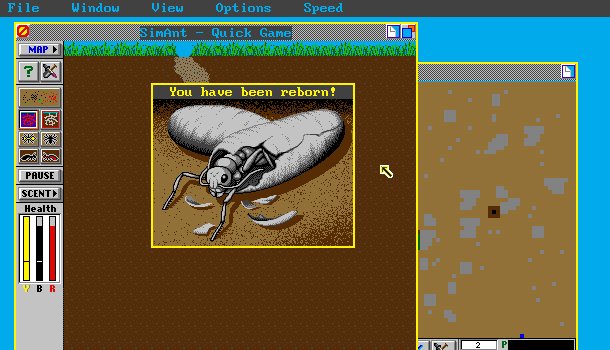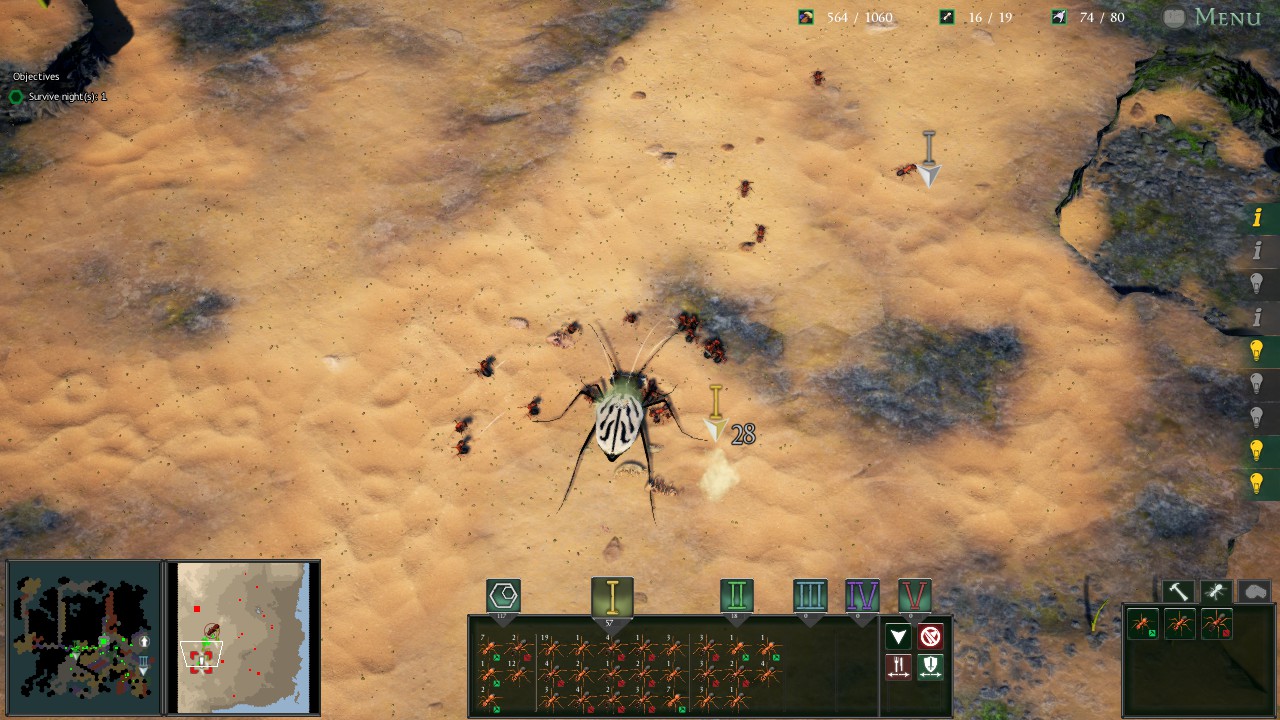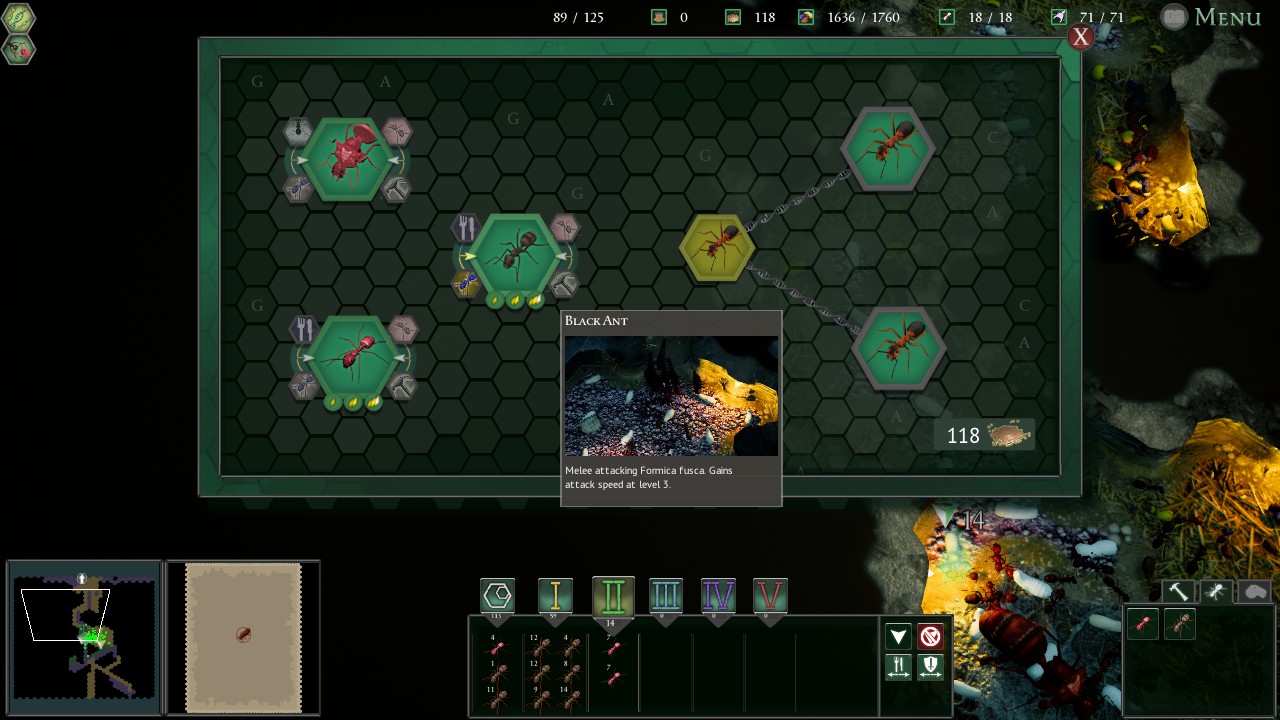Is Empires of the Undergrowth a worthy successor to SimAnt?
"You have been reborn!"

Over Christmas this year in sunny Adelaide, South Australia, my son and I ran 5k most mornings, pausing only to marvel at the dirt teeming with vast numbers of ants. Why did they travel in lines? Where were they going? Why were they carrying toenail clippings, but not a half-eaten sandwich someone had dropped? We swatted a lot of ants from our legs as we pondered these questions.
Like any good parent, I knew where to find answers: SimAnt on the Internet Archive. What is SimAnt? Some edutainment title? Not in the slightest. In 1991, you played SimAnt not to learn stuff but to prove you could take down a spider and wage war in the kitchen. I’d almost forgotten that the manual was basically a 107-page thesis and that SimAnt’s design hinged on the idea of colonies as superorganisms.
Why did the black ants follow the yellow ant to and from food? It left a pheromone trail, visible with a toggle. Why would ants puke into the yellow ant’s mouth when its health was low? According to the manual, this process is called trophallaxis and as the designers wryly note is "not a pretty sight", which is why they decided to animate it. SimAnt was Maxis’ third sim, after SimCity and SimEarth, and it was a unique experience.

"Where is my SimAnt spiritual successor?" I asked Twitter. A friend pointed me to Empires of the Undergrowth, which their Kickstarter page notes is influenced by both SimAnt and Dungeon Keeper.
...my queen was casually destroyed (to increasingly dissonant piano music). My motivation for beating Empires of the Undergrowth is now to exact revenge.
The Early Access build made me feel like an ant-obsessed 13-year-old all over again. Empires is certainly recognizable as a SimAnt successor but it’s not a direct remake. Both games employ pheromones in directing ant behavior, for example, but you don’t play as just one ant in Empires. Instead, you assign ants to groups and drop pheromone markers for them to follow. This fleshes out the real-time strategy elements, affording the player more control over units rather than having to rely on overwhelming numbers in battle.
Also, instead of simply piling food and eggs into a nest, you 'purchase' hexes for storage and nurseries with excess food gathered from a range of sources. Some are benign, like seeds and weevil larvae. Others are scary, like the Devil’s coach-horse beetle. Adjacent nursery tiles generate chambers of ants who must be assigned to pheromone markers together and these can be upgraded when more food is available.

Empires’ premise is that scientists have discovered a new species of ant that can steal genetic material from its foes—Formica ereptor. On completion of missions (narrated by a documentary filmmaker, who delivers what functions as both commentary and instruction), the player can use royal jelly to specialize new ants via a tech tree, as if they were assimilating DNA.
Keep up to date with the most important stories and the best deals, as picked by the PC Gamer team.
A mission concludes, and you return to the laboratory’s formicarium to continue developing the persistent colony. To unlock more missions, you test the formicarium against unpredictable, hilarious, and infuriating challenges. The first time I tried one, my queen was casually destroyed (to increasingly dissonant piano music). My motivation for beating Empires of the Undergrowth is now to exact revenge.
It’s like in SimAnt, when I first zoomed out to the yard and saw a man stomping around, complaining about food. After he carelessly squished one too many of my brave soldier ants, it was time to turn his stupid, blue house into a swarming mess. I don’t know how Empires will play out, but I’d like to ruin some scientists’ lunches, perhaps carelessly left next to the formicarium. Or maybe that’s just me.
Vengeance is a helpful motivation to have as a mass of crawling insects. Usually in games you have a clearly defined character, whether a witcher or an arctic fox, but there’s a different kind of agency to being, as SimAnt’s manual describes it, "the intelligence of a colony".

Pages 63-65 of SimAnt’s manual outlined outrageously detailed ways to cheese the game. I’ll spoil one: "Sneak into the red nest and dig lots of deep holes. The red queen might go too deep and drown in the next rain." Would an ant really do that? Or do you have to have a human brain to dream this up? SimAnt was (resolutely) a sim, but Empires seems more content to be a game.
...the first time I saw a cute little hermit crab scuttling towards my colony, my heart gave a flutter. (Then we consumed it, presumably as regurgitated liquid.)
As such, in SimAnt, you could (for the most part) guarantee success with a conservative approach to overwhelming your enemies. Empires balances authentic melee and ranged units (wood ants really do spit acid) with helpful controls, like being able to turn off food collection during battle, to alleviate frustration. It’s a compromise, but one that has been implemented elegantly.
At the beach the tide demolishes swathes of ants (like SimAnt’s lawnmower) unless you’re paying attention to a timer. Would ants know when the tide is coming in? I’m not sure. Would the player freak out over an unexpected mass drowning? Probably. My favorite moments in Empires occur when the ants’ fragility is emphasized by the level and scenario design, but learning doesn’t always have to come via punishment.

This is from SimAnt’s manual: "Food is shown in SimAnt as green balls. On a black and white monitor, they won't be green, but they will be balls." Modern technology allows Empires to more beautifully represent nature, and the first time I saw a cute little hermit crab scuttling towards my colony, my heart gave a flutter. (Then we consumed it, presumably as regurgitated liquid.)
You may also want to be aware of "arachnophobe mode". I’m Australian and most definitely not afraid of spiders, but the wolf spiders are very realistic. My skin actually crawled when two invaded the nest, accompanied by dramatic orchestral music.

SimAnt’s manual defines SimAnt not as a game but a "software toy", including the following (amazing) example to illustrate the difference between the two. "With a ball, you can play tennis (a game). You can play catch. You can throw it at someone. You can bounce it. You can make up a hundred different games. Besides games, there are other things you can do with a ball. You can paint it, use it to plug a leaky roof, or just contemplate its roundness."
Especially in Experimental mode, that was SimAnt. The manual even suggested you build a walled arena, fill it with antlions and pit ants against each other in battle. "Throw in a spider to add to the thrills." It was like being a kid, making sand islands in the gutter after it rained and marooning ants on them, just to see what they did next. By contrast, Empires of the Undergrowth is definitely a game, with directed scenarios and explicit progression. But ideas like "childish curiosity" and "natural beauty" underpin the design nonetheless.
How authentic are SimAnt and Empires as ant colony-building experiences? I’m no myrmecologist but I have accidentally learned a lot about ants by playing them. And the more I can talk about ants, the longer the break I can take when my son and I next go for a run.
Empires of the Undergrowth is currently in Early Access.

